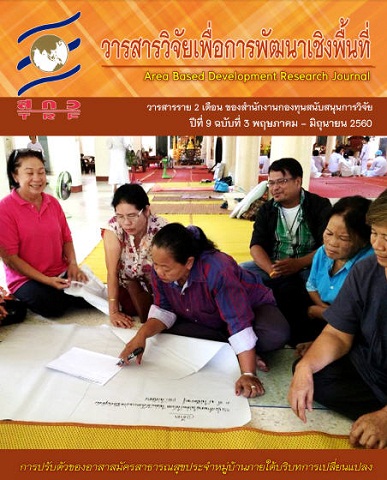กระบวนการมีส่วนร่วมในการจัดการขยะที่ต้นทางเพื่อลดปริมาณขยะของชุมชนนาราชควาย จังหวัดนครพนม
Main Article Content
Abstract
ปัจจุบันประชาชนในชุมชนนาราชควาย อำเภอเมือง จังหวัดนครพนม ได้รับความเดือนร้อนจากปริมาณขยะมูลฝอยที่เพิ่มขึ้น เช่น กลิ่นเหม็น น้ำเน่าเสีย และทัศนอุจาด เป็นต้น เป็นเหตุให้เกิดข้อร้องเรียนของคนในชุมชน ดังนั้นผู้วิจัยจึงศึกษากระบวนการมีส่วนร่วมในการจัดการขยะที่ต้นทางเพื่อลดปริมาณขยะของชุมชนนาราชควาย โดยการวางแผนการเรียนรู้ร่วมกันแบบชี้แนะแนวทาง การสอบถาม การประชุมกลุ่มย่อย ระดมสมอง สรุป นำเสนอผลการเรียนรู้ร่วมกัน และทดลองปฏิบัติ ผลการวิจัยพบว่า ก่อนมีการดำเนินโครงการ ชุมชนนาราชควายมีปริมาณขยะจำนวน 3.5 ตันต่อวัน ทำการกำจัดโดยการนำขยะไปฝังกลบ แต่ในปัจจุบันหลุมฝังกลบใกล้เต็มแล้ว และมีปัญหาขยะล้นถัง สร้างความเดือดร้อนให้กับประชาชนในชุมชน ซึ่งปัญหาดังกล่าวทำให้ประชาชนในชุมชนได้เรียนรู้จากสถานการณ์ที่เกิดขึ้นจริง จึงได้ร่วมกันหาแนวทางแก้ไขปัญหาอย่างมีส่วนร่วม ภายใต้ข้อจำกัดของงบประมาณ และเวลา โดยที่ประชุมลงมติเลือกวิธีการจัดตั้งธนาคารขยะ หมู่ที่ 11 บ้านนาราชควาย พบว่าประชาชนส่วนใหญ่ให้ความร่วมมือเป็นอย่างดี เริ่มต้นมีสมาชิกเข้าร่วมโครงการถึง 190 คน ประชาชนส่วนใหญ่เก็บขยะเพื่อขายกับธนาคารขยะแทนการขายให้กับซาเล้งดังที่เคยทำมาในอดีต เหตุผลเพราะว่า ธนาคารขยะมีสวัสดิการที่ดีกว่า เช่น มีเงินปันผล เงินช่วยเหลือค่าฌาปณกิจศพ เงินกู้ยืม เป็นต้น ผลในด้านการลดลงของปริมาณขยะที่นำไปฝังกลบพบว่า หลังดำเนินกิจกรรมธนาคารขยะเป็นระยะเวลา 2 เดือน สามารถลดปริมาณขยะได้ถึง 7,640 กิโลกรัม ทำให้สามารถยืดอายุของหลุมฝังกลบ และบรรเทาปัญหาการเพิ่มขึ้นของขยะมูลฝอยได้
Participation in Waste Management Process in the Initial Stage for Reducing Wastes in Naratkwai Community, Nakhonphanom Province
People in Naratkwai sub-district, Muang district, Nakhonphanom province has been suffering from increasing amounts of wastes which lead to unpleasent smell, waste water and environmental problems. These problems led to public complaints. Hence, the aim of this study was to investigate the participation in waste management process in the initial stage for reducing wastes in Naratkwai by planning as a guided cooperative learning process and cooperative of inquiry, observation, brainstorming, discussion and presentation. The result showed
that before the project execution, the wastes of Naratkwai was approximately 3.5 ton/day which were eliminated by the landfill. Currently overflowing waste bins and landfill affected the community members. For this reason, people started to realize the problem situation and attempted to find the solution together. The suitable solution for this community under the budget and time limitation was the establishment of the waste bank, which encouraged community members to pay more attention to the classification of the waste at the initial stage. The practice result showed that from the establishment of the waste bank in Naratkwai moo.11, the community members cooperated very well. At the beginning, the number of people who were interested and joined as a member was as high as 190 persons. People together managed the waste bank. Most people kept their wastes to sell at the waste bank instead of selling to the freight bicycle because the waste bank offered extra welfare such as annual dividend, the cremation and loan payments. Besides, the bank always exhibited the updated waste price list. These conducts built the public confidence could explicitly reduce the amount of waste. After 2 months, the amount of the waste was reduced by 7,640 kg. This can prolong the life of the landfill and efficiently reduce the waste problem from the initial stage.
Article Details
Area Based Development Research Journal values copyright protection and licensing to safeguard author rights and facilitate the appropriate dissemination of research. Our policies ensure openness, accessibility, and attribution. Authors retain copyright ownership, and articles are published under a Creative Commons Attribution License (CC BY), allowing sharing, adaptation, and proper attribution. Authors have the freedom to publish under the CC BY license, granting broad reuse and distribution permissions. The journal supports posting articles on third-party repositories, adhering to institutional and funding restrictions. Author guidelines detail copyright and licensing requirements, empowering authors with knowledge about their rights and responsibilities. These policies cultivate an environment of collaboration, openness, and responsible sharing, benefiting authors and the research community while honoring intellectual property rights.


